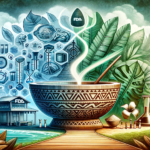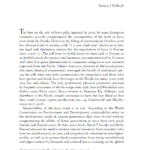Summary of: Kava and Christianity in Central Vanuatu: With an Appendix on the Ethnography of Kava Drinking in Nikaura, Epi. By Michael Young. 1995.

Citation: Young, Michael W. 1995. “Kava and Christianity in Central Vanuatu: With an Appendix on the Ethnography of Kava Drinking in Nikaura, Epi.” Canberra Anthropology 18 (1-2): 61–96. https://www.tandfonline.com/doi/pdf/10.1080/03149099509508409.
Fast Summary:
- The paper titled “Kava and Christianity in Central Vanuatu” by Michael W. Young explores the complex relationship between kava consumption and Christianity in Vanuatu, focusing on the historical, cultural, and social aspects.
Full Summary:
- Introduction (Page 61):
- The paper “Kava and Christianity in Central Vanuatu” by Michael W. Young delves into the intricate relationship between kava consumption and Christianity in the archipelago of Vanuatu. The paper starts by presenting two contrasting perspectives on kava. Early missionaries in the New Hebrides (now Vanuatu) condemned the plant as a symbol of heathenism and a source of intoxication. However, in modern times, educated ni-Vanuatu, who are Christians, celebrate kava as a symbol of their national identity. The paper notes a resurgence in kava-drinking since the 1970s, despite initial opposition from the Presbyterian Church. The national government has even promoted it as a healthy alternative to alcohol.
- Emergence of Secular and Urbanized Pattern of Kava-Drinking (Page 63):
- Young discusses the transformation in kava consumption patterns over time. Initially, it was consumed as a symbolic practice tied to identity and tradition. However, it has evolved into a secular and urbanized pattern where men primarily consume it for pleasure. The paper also delves into the Presbyterian Church’s historical opposition to kava and how drinking it has eventually found a place within local Christian practices.
- Christianity Against Kava (Page 64-65):
- The paper explores the ideological attacks on indigenous cultures by Christians, which included strong opposition to kava-drinking. The paper argues that these attacks were not just limited to the Presbyterians but were a broader Christian phenomenon. The paper aims to systematically assess the ideological reasons behind the Presbyterian Church’s opposition to this time honored tradition, noting that while some Christian denominations were tolerant its consumption, the Presbyterians were notably antagonistic.
- Missionary Objections to Kava (Page 66-67):
- Young categorizes the objections to kava into five main areas: cultural, moral, theological, hygienic, and political. Cultural and moral objections focus on kava’s intoxicating effects and its association with heathen practices. Theological objections are rooted in the belief that kava is linked to spirit-worship. Hygienic objections claim that kava preparation and consumption are unclean and unhealthy. Political objections highlight the power struggle between missionaries and local communities, with kava becoming a symbol of resistance against Christian influence.
- Kava’s Role in Social and Political Context (Page 68-69):
- The paper examines the political and counter-hegemonic role of kava in various islands of Vanuatu, including Nguna, Emae, Tongoa, and Epi. It discusses how missionaries attempted to control social practices like kava drinking and how local communities resisted these efforts. The paper also mentions the formation of the “Tee-Total and Anti-Tobacco Club” by Peter Milne of Nguna Island as part of broader efforts to suppress kava and other substances.
- Ethnography of Kava Drinking in Nikaura, Epi (Appendix):
- The paper includes an ethnographic account of kava-drinking practices in the village of Nikaura on the island of Epi. It explores how kava has the power to provoke missionary condemnation but also to achieve accommodation with that opposition. The paper notes that kava-drinking, to some extent, subsidizes the practice of local Christianity in Nikaura.
Notes:
- Overall, Michael W. Young’s paper offers a comprehensive analysis of the complex relationship between kava and Christianity in Central Vanuatu. It delves into the historical opposition by the Presbyterian Church, the cultural significance of kava, and the intricate interplay between kava, identity, and resistance to missionary control. The paper serves as an important resource for understanding the multifaceted role of kava in Vanuatu’s social, cultural, and religious landscape.




